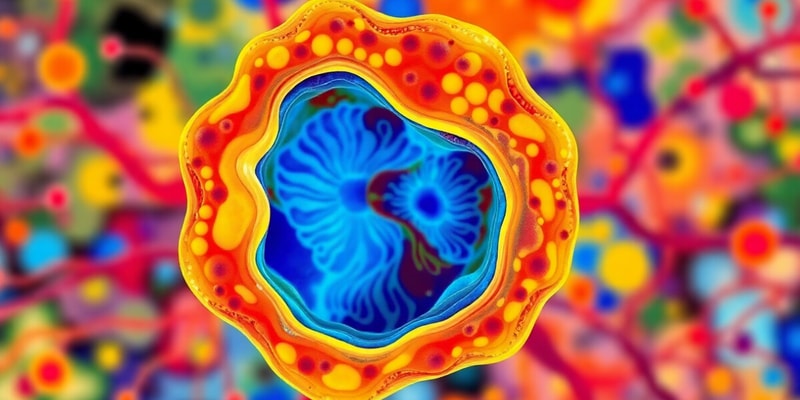Podcast
Questions and Answers
What is the main reason researchers use model systems in biological studies?
What is the main reason researchers use model systems in biological studies?
Which of the following is a limitation of using E.coli as a model organism?
Which of the following is a limitation of using E.coli as a model organism?
What is an advantage of using yeast as a model organism?
What is an advantage of using yeast as a model organism?
Which of the following correctly describes a feature of mammalian systems like mice?
Which of the following correctly describes a feature of mammalian systems like mice?
Signup and view all the answers
Which type of model organism is best characterized by rapid growth and efficiency in genetic manipulation?
Which type of model organism is best characterized by rapid growth and efficiency in genetic manipulation?
Signup and view all the answers
Which aspect is NOT a purpose of commonly used experimental techniques in model systems?
Which aspect is NOT a purpose of commonly used experimental techniques in model systems?
Signup and view all the answers
What is a key disadvantage of single-cell model organisms like E.coli?
What is a key disadvantage of single-cell model organisms like E.coli?
Signup and view all the answers
Which statement is true regarding the growth characteristics of yeast?
Which statement is true regarding the growth characteristics of yeast?
Signup and view all the answers
What is the average generation time for a mouse?
What is the average generation time for a mouse?
Signup and view all the answers
What is a primary disadvantage of using transformed cell lines?
What is a primary disadvantage of using transformed cell lines?
Signup and view all the answers
Which type of stem cells can be used to initiate organoids?
Which type of stem cells can be used to initiate organoids?
Signup and view all the answers
Why are organoids considered to be more physiologically relevant than traditional 2D cultures?
Why are organoids considered to be more physiologically relevant than traditional 2D cultures?
Signup and view all the answers
What feature of neurons in cerebral organoids was observed in 2017?
What feature of neurons in cerebral organoids was observed in 2017?
Signup and view all the answers
How do organoids contribute to genetic manipulation compared to in vivo models?
How do organoids contribute to genetic manipulation compared to in vivo models?
Signup and view all the answers
Which of the following best describes organoids?
Which of the following best describes organoids?
Signup and view all the answers
What is the central feature of the mouse intestinal organoids identified in 2009?
What is the central feature of the mouse intestinal organoids identified in 2009?
Signup and view all the answers
Study Notes
Model Systems in Cell Biology
- Model systems are simplified versions of complex entities, capturing key characteristics needed for study.
- Using models is often more practical or ethical than studying the actual entity (e.g., human disease).
Types of Model Systems
-
Single-cell organisms (e.g., E. coli):
- Fast growth in chemically defined media.
- Relatively inexpensive culture media.
- Extensive knowledge of genetics and genomics.
- Knowledge of transcriptome, proteome, and metabolome.
- Some strains are considered biosafety level 1 (e.g., E. coli K12).
- Disadvantage: may not have the same protein modifications (e.g., glycosylation) as more complex systems.
-
Single-cell eukaryotes (e.g., Yeast):
- Rapid growth (1.5-2.5 hours)
- Non-pathogenic
- Efficient transformation by exogenous DNA.
- Efficient homologous recombination.
- Simple genetic screens.
- Similar cellular processes to humans
-
Mammalian systems (e.g., Mice):
- Closely related to humans, with similar anatomy, physiology, and genetics.
- Short generation time (approx. 10 weeks).
- Amenable to genetic manipulation (e.g., knockouts, knock-ins).
- Conditional expression lines exist for targeted gene manipulation.
-
Cell culture:
- Cells isolated from a system and grown in vitro.
- Cheaper than studying a whole organism.
- Greater opportunities for perturbation and measurements.
- Often transformed, losing some in vivo properties and introducing artefacts.
-
Organoids:
- In vitro 3D cellular clusters derived from stem cells (ESCs, iPSCs, or tissue resident stem cells).
- Self-organization and self-renewal abilities.
- Model diverse tissues (e.g., brain, intestine, liver, pancreas).
- More physiologically relevant than 2D cultures.
- More amenable to manipulation of niche components, pathways, and genome editing compared to in vivo models.
Learning Outcomes (Lecture 20)
- Explain why researchers use models.
- Describe different types of model systems, including their advantages and limitations. Examples; Single-cell, Multicellular, Mammalian systems, Computational models.
- Describe the purpose of commonly used experimental techniques.
Model Organisms for Biological Processes
- A diverse range of non-human species, such as Zebrafish, Mice, Drosophila (fruit flies), and E. coli, are valuable model systems.
Measurement Methods
- Different levels of biological analysis (DNA, RNA, protein) require specialized methods.
- Examples include qPCR (Quantitative PCR), in situ hybridisation, SDS-PAGE (sodium dodecyl sulfate polyacrylamide gel electrophoresis, western blotting), immunochemistry and ELISA (enzyme-linked immunosorbent assay).
- Whole genome sequencing, RNA sequencing and Mass Spectrometry
Studying That Suits You
Use AI to generate personalized quizzes and flashcards to suit your learning preferences.
Related Documents
Description
Explore the use of model systems in cell biology, focusing on various types such as single-cell organisms, single-cell eukaryotes, and mammalian systems. Understand their advantages, disadvantages, and applications in studying complex biological processes. This quiz covers key characteristics needed for the study of these simplified biological models.




